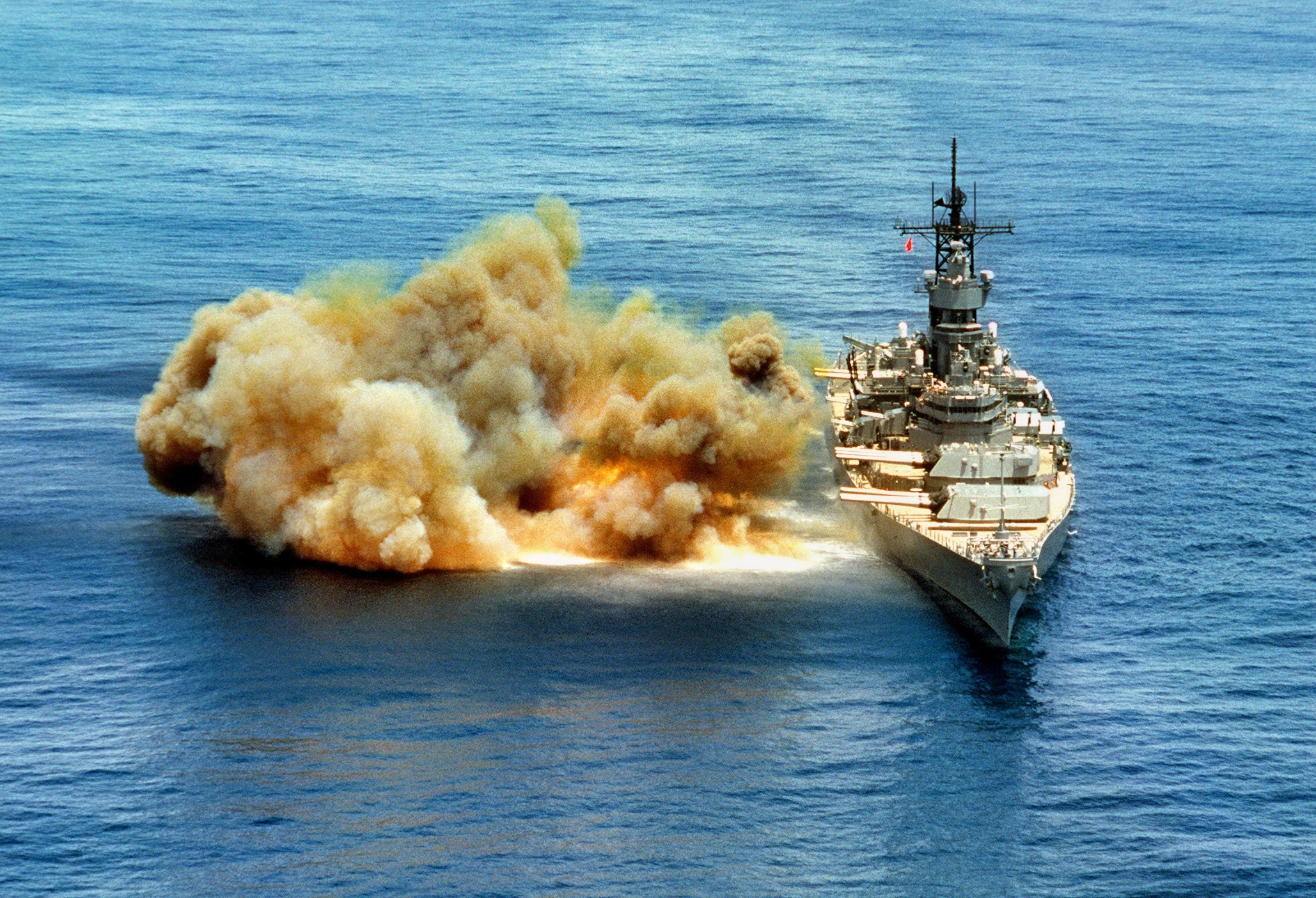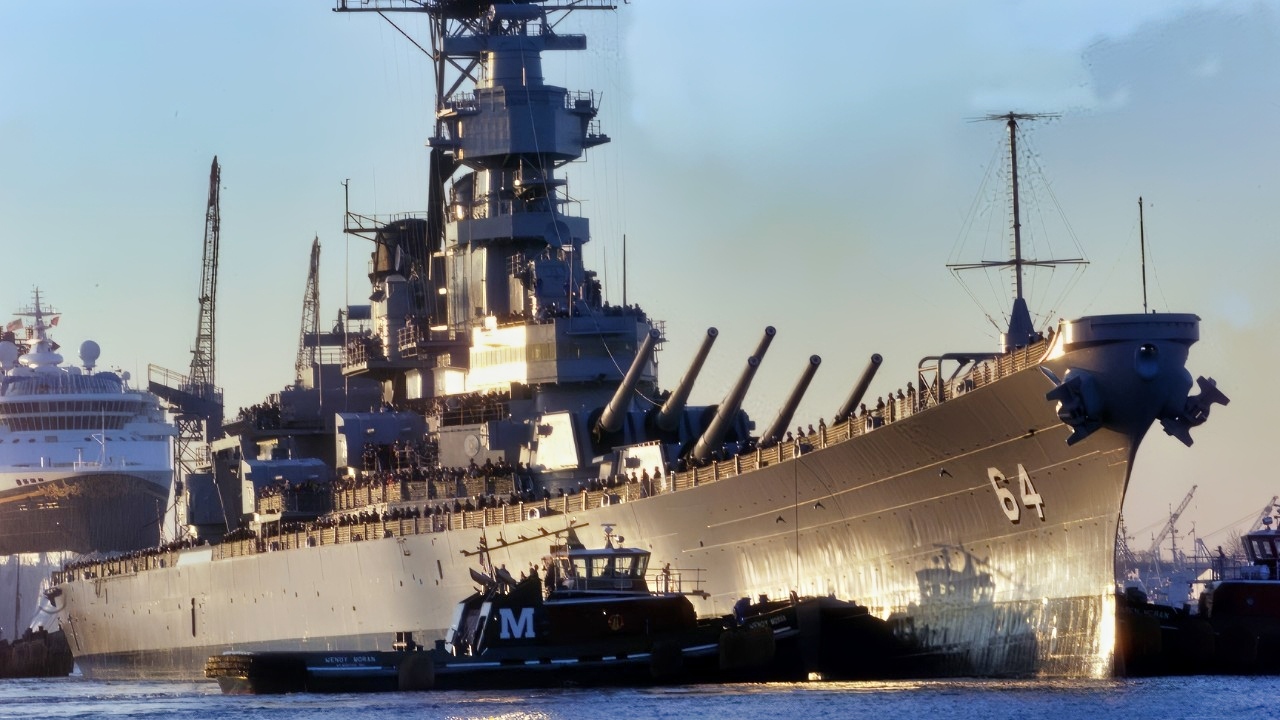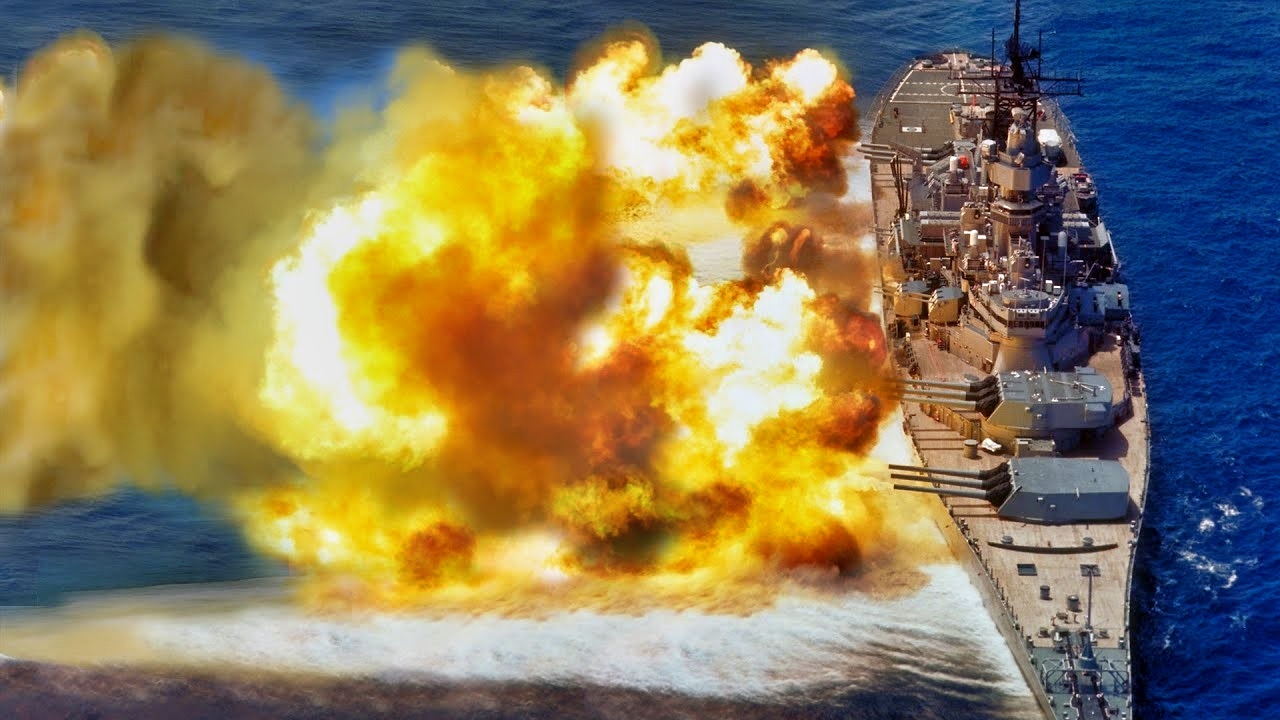Key Points and Summary – Conceived in 1940 as the apex of American battleship design, the Montana-class traded the Iowas’ speed for thicker armor and twelve 16-inch/50 guns in four triple turrets.
-Wider than Panama Canal limits and built around a massive citadel and advanced dual-purpose battery, they were meant to outlast anything afloat and answer Japan’s Yamato-class.
-But the Pacific air war made carriers decisive. Yard space, steel, and manpower flowed to Essex-class carriers, landing craft, and fast escorts.
-The five Montanas were canceled in 1943 before keels were laid. Their unbuilt plans still shaped U.S. naval thinking about protection, fire control, and the limits of gun power in the carrier age.
Montana-Class: America’s Ultimate Battleships That Never Sailed
By 1940, Washington faced two realities. First, treaty ceilings that had constrained battleship size through the 1930s were effectively dead. Second, intelligence on Japan’s new super-battleships—what the world would later recognize as the Yamato-class—suggested the Pacific might see combat between behemoths unlike anything before. The U.S. Navy wanted a ship that could absorb punishment and hit back harder than the fast Iowa-class, while doubling as a floating anti-aircraft fortress for amphibious operations.
The answer on paper was the Montana-class: heavier armor, more big guns, deeper magazines, a broader beam for better underwater protection, and a dual-purpose secondary battery tuned for the increasingly lethal air threat.
And yet, here we are: the warships were never built. Why?
Building On Iowa’s Legacy—By Making Different Tradeoffs
The Iowa-class embodied “fast wing of the battle line”—33-knot sprinters able to run with carriers. Montana came from a different design philosophy: win the armor and firepower game, accept ~28-knot speed, and deliver the hardest broadside any U.S. battleship ever could.
Key ways Montana-class would have built on Iowa:
Firepower: From nine to twelve 16-inch/50 Mark 7 guns (four triple turrets rather than three), increasing salvo weight and the chances of straddles at long range.
Protection: A thicker belt and deck, a larger armored citadel, and a wider torpedo-defense system—made possible by a beam too broad for the Panama Canal’s old locks.
Dual-Purpose Battery: Shift from Iowa’s 5″/38s to a heavy suite of 5″/54 twin mounts—higher muzzle velocity, longer reach, and better punch against both aircraft and surface targets.
Growth Margin: More internal volume for magazines, AA ammunition, fire-control spaces, and electrical power—vital as radar and directors multiplied.
In Short: Iowas were greyhounds; Montanas would have been brawlers.
The Montana-Class Design Concept: A Bigger Citadel Around Familiar Guns
U.S. designers did not change what already worked. The 16-inch/50 Mark 7 gun family—renowned for accuracy, long barrel life, and superb AP projectiles—remained the main battery. The novelty was scale and protection:
Armored Citadel: The “all-or-nothing” scheme was carried to its logical end: magazines and machinery sat behind substantially thicker side and deck armor than Iowa, with turret faces in the 20-inch-class.

Montana-Class Battleship. Image Credit: Creative Commons.
Underwater Defense: A deeper, multi-layered torpedo-defense system used the extra beam to dissipate a warhead’s gas bubble and fragment energy before it could rupture inner bulkheads.
Stability & Seakeeping: A broader hull and heavier armor raised challenges in weight distribution, but also promised a steady gun platform in the North Pacific’s bad weather.
Montana was evolution, not revolution—pushing a proven American design logic to its peak.
Main Battery: Twelve Reasons To Stay Out Of Range
Arranged in four triple turrets (two forward, two aft), the 16-inch battery would have offered:
Weight Of Fire: A twelve-gun broadside improves hit probability in ranging sequences and saturates a target’s armor scheme with multiple impact angles.
Shell Quality: With advanced armor-piercing shells and delayed-fuse design, U.S. naval gunnery excelled at deck-penetration at long range, exactly where Pacific fights increasingly occurred.
Fire Control: Radar ranging and stable vertical directors, already combat-proven by mid-war, would only improve with more power and space for equipment and operators.

USS Missouri Iowa-Class Battleship. Image Credit: Creative Commons.
Against any contemporaneous opponent, Montana’s main battery was not just bigger; it was better integrated into a radar-centric fire-control ecosystem.
Secondary And Anti-Air Suite: A Floating AA City
The class would have mounted around twenty 5″/54 guns in ten twin mounts—a step change from the ubiquitous 5″/38 in reach and punch. Around this core, designers planned a dense forest of Bofors 40 mm in quadruple and twin mounts and Oerlikon 20 mm for close-in defense. As kamikaze tactics emerged, that density mattered: Montana’s deck space and electrical capacity could accommodate more mounts, more directors, and more ammunition handling gear than any previous U.S. battleship.
Powerplant And Speed: Enough, Not Excess
Designers targeted high-20s knots—fast enough to keep station with traditional battle lines and support amphibious operations, but slower than carrier task forces at sprint. The payoff for relinquishing the Iowa’s top-end speed was substantial: more armor weight, deeper torpedo blisters, and the fourth triple turret. In the gun-duel mission, that was a good trade.
The Panama Problem—and Why It Was Intentional
Montana’s beam exceeded the old Panama Canal lock limits. That wasn’t an oversight; it was a conscious decision to prioritize protection and stability over canal transit. (A wartime project to build larger canal locks began but was halted as priorities shifted.) The Navy accepted that Montanas would move between oceans by round-the-horn routing if needed—rare, but acceptable for ships meant to dominate a single theater.

An aerial bow view of the battleship USS IOWA (BB 61) with its 15 guns (nine 16-inch and six 5-inch) firing a salvo off the starboard side. Image Credit: Creative Commons.
Would They Have Been The Best Battleships Ever?
On paper, yes—among the very best. Consider the fact:
Versus Yamato: Montana’s radar fire control, shell quality, and higher rate and density of fire from twelve 16-inch guns would have offset Yamato’s larger 18.1-inch rounds. With thicker armor than Iowa and an immunity zone tuned for long-range fire, Montana was designed to survive and keep shooting.
Versus Iowa: Iowa kept the speed crown; Montana kept the staying power crown. In a straight gunnery duel at range, Montana’s extra turret and heavier armor were decisive advantages.
AA Role: As an AA platform, Montana’s larger deck plan and electrical margin allowed more mounts and directors, improving survivability for herself and nearby ships.
But “best battleship” became the wrong question the moment carriers and land-based air set the terms of battle.

Iowa-Class Battleship Coming Home. Image Credit: Creative Commons.
Why The Navy Passed: Aircraft Carriers Changed The War
Between 1942 and 1943, the Pacific war clarified brutally: airpower decided campaigns. Steel, labor, propulsion machinery, and yard slots had to go where they returned the most sorties—that meant Essex-class carriers, Independence-class light carriers, escort carriers, destroyers, destroyer escorts, and amphibious shipping. Even battleships still on the ways were justified mostly as AA screens and shore-bombardment platforms.
Montana’s five authorized hulls (BB-67 through BB-71) were canceled in 1943 before keels were laid. The decision freed capacity to accelerate carriers and the ships that made carriers lethal. It wasn’t a repudiation of Montana’s design; it was an acknowledgement that strategy had moved on.
Operational History That Never Was—And What We Can Infer
Had Montana commissioned in late war or just after, she likely would have:
Led Shore Bombardments: Against fortified islands and, later, in Korea, a twelve-gun battery with radar spotting would have been devastating.
Served As AA Anchor: With more 5″/54s and directors than any predecessor, Montana would have been a node in layered air defense.
Deterred Surface Action: Few adversaries would risk a gun duel with a ship that could out-range and out-absorb anything short of a torpedo salvo or heavy air attack.
In the missile era, however, her career would have mirrored Iowa’s late-life arc: prestige flagship, bombardment specialist, then a retirement as missiles and aviation rewrote the surface-warfare playbook.
The “What-If” Fight: Would Montana Beat Everyone?
“Best” depends on the fight you choose. In a radar-ranged, long-distance gunnery duel, Montana-class had every advantage the U.S. could engineer: excellent shells, twelve-gun salvos, heavy armor, powerful fire control, and a stable platform. Against massed air attack without a friendly air umbrella, any battleship’s fate became a function of the attackers’ numbers and doctrine. Montana’s AA density improves the odds—but it doesn’t change physics.
The Cancellation’s Logic: Scarcity, Not Sentiment
Canceling five world-class battleships was not easy. But every thousand tons of armor plate and every ship-month in drydock could produce multiple escorts or a chunk of a carrier. The Navy asked a wartime question: What wins campaigns now? The answer kept coming back: pilots, decks, fuel, and the logistics to sustain them. Montana lost a contest not of ideas, but of opportunity cost.
Legacy: The Last Word In “All-Or-Nothing”
Even unbuilt, Montana left fingerprints:
Confidence In Radar Gunnery: The design cemented the U.S. conviction that electronics and gunnery were inseparable—a mindset later mirrored in missile fire control.
Protection Doctrine: The deeper torpedo defense and heavier deck/belt relationships informed postwar survivability studies and even Cold-War thinking about armored ships versus guided weapons.
A Design Boundary: Montana marked the practical limit of the gun battleship—the point at which more armor and guns still lost to the economics of airpower.
Why The “Best Battleships Ever” Still Lost The Future
Aircraft carriers scaled combat power in ways guns could not. A single flight deck could project hundreds of precision sorties in days, change axes of attack at will, and strike beyond the horizon without telegraphing a gun line’s approach. As sensors, logistics, and training improved, the sortie machine beat the salvo machine—not because the salvo was weak, but because airpower was multiplicative.
Montana would have been a magnificent ship. She also would have been a magnificent anachronism within a few years of commissioning.
Lessons For Today
Design For The War You’ll Fight, Not The One You Loved. Montana was perfectly tuned for a duel the Pacific no longer prioritized.
Opportunity Cost Is Strategy. The hardest choices aren’t technical; they’re about what not to build so you can field what wins.
Survivability Is Systemic. Montana improved ship-level survival brilliantly; carriers improved fleet-level survival by pushing the fight outward.
Final Verdict on the Montana-Class
The Montana-class was America’s endgame for the battleship: twelve 16-inch guns, fortress-level protection, and a secondary battery built for the sky as much as the sea. On the drawing board, they were likely the most combat-credible battleships ever conceived. In the real world of 1943, they were less useful than the next carrier, the next destroyer squadron, and the next wave of Marines who needed sea-based air overhead.
The Montana-class story isn’t a failure; it’s a proof of discipline. The Navy knew what it was capable of—and what would actually win. So it let the best battleships in history remain blueprints, and built victory instead.
About the Author: Harry J. Kazianis
Harry J. Kazianis (@Grecianformula) is Editor-In-Chief and President of National Security Journal. He was the former Senior Director of National Security Affairs at the Center for the National Interest (CFTNI), a foreign policy think tank founded by Richard Nixon based in Washington, DC. Harry has over a decade of experience in think tanks and national security publishing. His ideas have been published in the NY Times, The Washington Post, The Wall Street Journal, CNN, and many other outlets worldwide. He has held positions at CSIS, the Heritage Foundation, the University of Nottingham, and several other institutions related to national security research and studies. He is the former Executive Editor of the National Interest and the Diplomat. He holds a Master’s degree focusing on international affairs from Harvard University.
More Military
Russia’s ‘New’ Kirov-Class Battlecrusier Is Like a ‘Death Star’
The U.S. Military’s Big X-44 Manta Stealth Fighter ‘Mistake’ Still Stings
China’s New Fujian Aircraft Carrier Looks Close to Fully Operational
The Air Force Could Soon Have 32 Additional F-22 Combat Ready ‘Raptor’ Stealth Fighters
China’s J-20 Mighty Dragon vs. Russia’s Su-35 Flanker Fighter: Who Wins Summed Up in 4 Words










